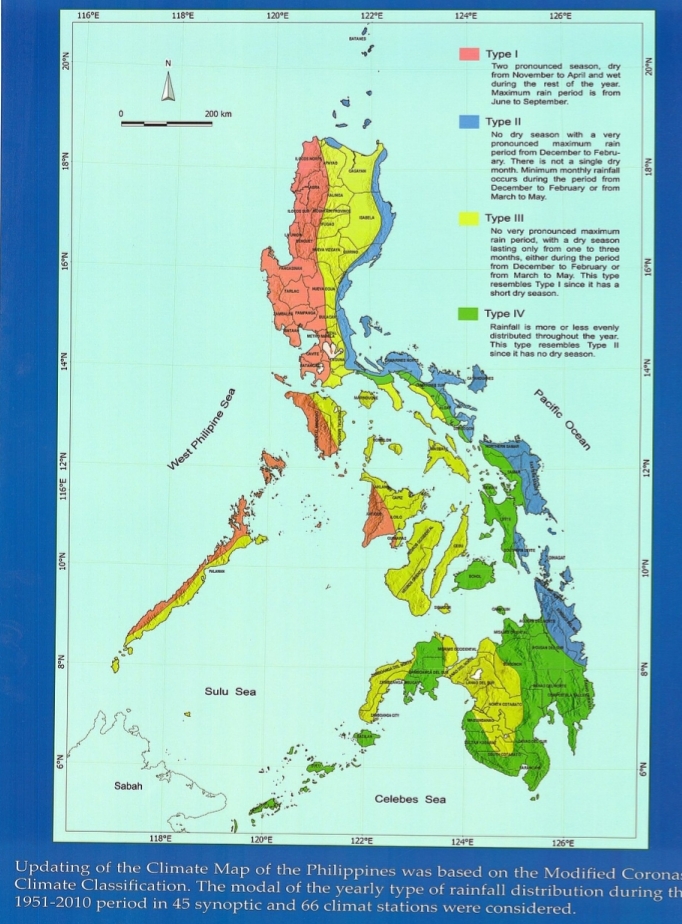Why does the climate map of the Philippines have different types based on the color provided by the picture above?
Why does the climate map of the Philippines have different types based on the color provided by the picture above?
Applications and Investigations in Earth Science (9th Edition)
9th Edition
ISBN:9780134746241
Author:Edward J. Tarbuck, Frederick K. Lutgens, Dennis G. Tasa
Publisher:Edward J. Tarbuck, Frederick K. Lutgens, Dennis G. Tasa
Chapter1: The Study Of Minerals
Section: Chapter Questions
Problem 1LR
Related questions
Question
Why does the climate map of the Philippines have different types based on the color provided by the picture above?

Transcribed Image Text:20°N
18°N
N.91
NetT
116°E 12 N
N-01
8°N
N₂9
116°E
Sabah
118°E
118°E
200 km
st Philipine Se
Sulu Sea
120°E
120°E
T
HVA
META
BACA
122°E
0.
122°E
Celebes Sea
124°E
124°E
126°E
Type I
Two pronounced season, dry
from November to April and wet
during the rest of the year.
Maximum rain period is from
June to September.
Type II
No dry season with a very
pronounced maximum rain
period from December to Febru-
ary. There is not a single dry
month. Minimum monthly rainfall
occurs during the period from
December to February or from
March to May
Type III
No very pronounced maximum
rain period, with a dry season
lasting only from one to three
months, either during the period
from December to February or
from March to May. This type
resembles Type I since it has a
short dry season.
Type IV
Rainfall is more or less evenly
distributed throughout the year.
This type resembles Type II
since it has no dry season.
Pacific Ocean
126°E
N.02
NOBT
N.91
14°N
12°N
N-01
No8
N₂9
Updating of the Climate Map of the Philippines was based on the Modified Corona-
Climate Classification. The modal of the yearly type of rainfall distribution during the
1951-2010 period in 45 synoptic and 66 climat stations were considered.
Expert Solution
This question has been solved!
Explore an expertly crafted, step-by-step solution for a thorough understanding of key concepts.
Step by step
Solved in 2 steps

Recommended textbooks for you

Applications and Investigations in Earth Science …
Earth Science
ISBN:
9780134746241
Author:
Edward J. Tarbuck, Frederick K. Lutgens, Dennis G. Tasa
Publisher:
PEARSON

Exercises for Weather & Climate (9th Edition)
Earth Science
ISBN:
9780134041360
Author:
Greg Carbone
Publisher:
PEARSON

Environmental Science
Earth Science
ISBN:
9781260153125
Author:
William P Cunningham Prof., Mary Ann Cunningham Professor
Publisher:
McGraw-Hill Education

Applications and Investigations in Earth Science …
Earth Science
ISBN:
9780134746241
Author:
Edward J. Tarbuck, Frederick K. Lutgens, Dennis G. Tasa
Publisher:
PEARSON

Exercises for Weather & Climate (9th Edition)
Earth Science
ISBN:
9780134041360
Author:
Greg Carbone
Publisher:
PEARSON

Environmental Science
Earth Science
ISBN:
9781260153125
Author:
William P Cunningham Prof., Mary Ann Cunningham Professor
Publisher:
McGraw-Hill Education

Earth Science (15th Edition)
Earth Science
ISBN:
9780134543536
Author:
Edward J. Tarbuck, Frederick K. Lutgens, Dennis G. Tasa
Publisher:
PEARSON

Environmental Science (MindTap Course List)
Earth Science
ISBN:
9781337569613
Author:
G. Tyler Miller, Scott Spoolman
Publisher:
Cengage Learning

Physical Geology
Earth Science
ISBN:
9781259916823
Author:
Plummer, Charles C., CARLSON, Diane H., Hammersley, Lisa
Publisher:
Mcgraw-hill Education,